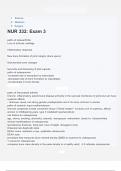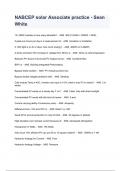STUVIA 2024/2025
1. Science
2. Medicine
3. Surgery
NUR 332: Exam 3
patho of osteoarthritis
Loss of articular cartilage
Inflammatory response
New bone formation of joint margins (bone spurs)
Subchondral bone changes
Synovitis and thickening of joint capsule
patho of osteoporosis
-increased rate of resorption by osteoclasts
-decreased rate of bone formation by osteoblasts
%
-net decrease in bone density
Brainpower
Read More
patho of rheumatoid arthritis
Chronic, inflammatory autoimmune disease primarily in the synovial membrane of joints but can have
systemic effects
- Unknown cause, but strong genetic predisposition and 2-3x more common in women
patho of systemic lupus erythematosus
immune complexes invade connective tissue ("Great Imitator"; involves a lot of systems), affects
women in childbearing years, type 3 mediated hypersensitivity
risk factors for osteoporosis
age, skinny, smoking, alcoholics, steroids, menopause, malnutrition, family hx, Asians/whites
clinical manifestations of osteoporosis
spontaneous fractures, back pain, loss of height, dowagers hump
Osteoporosis diagnostic tests
DEXA scans, standard x-rays, qualitative ultrasounds
DEXA scan
procedure that measures bone mineral density (BMD) to examine for osteoporosis
T scores for osteoporosis
compares bone mass density to the peak density to a healthy adult, -2.5 indicates osteoporosis
stuvia
, STUVIA 2024/2025
when should people be screened for osteoporosis
women 65 years and older, younger if at risk, if normal rescreen in 15 years
foods high in calcium
Milk, cheese, dark green vegetables, dried figs, sot, legumes
managing osteoporosis
increase in calcium and vitamin D, weight bearing exercise, prevent injury, risk reduction, implement
calcium and vitamin D supplements
calcium supplements
calcium carbonate and calcium citrate, take in divided doses not greater than 500 mg
Assessment of MS disorders
look for tenderness, swelling, limited movement, crepitation, deformity, loss of height, changes in
weight, do symptoms affect ADL's, assess joint pain and stiffness, assess bilaterally
patient focused outcomes of MS disorders
maintain or improve musculoskeletal function, with a balance of rest and activity, protect bones and
joints, avoid injury, ability to maintain independent, pain relief
nursing interventions for MS disorders
drug therapy, correct posture and body mechanics, correct use of assistive devices, brace to protect
joints, PT/OT, proper diet
Osteoarthritis
direct cartilage damage or joint instability from stress on joints
%
risk factors for osteoarthritis
Aging
Obesity
Genetics (chondrocytes)
Joint injury
Occupation (those that use same joints continuously, for example athletes)
Prior acl injury
menopause
clinical manifestations of osteoarthritis
asymmetric joint main, worsens with joint use, worsens with rest especially in AM, crepitus, loss of
function, deformity, depression
diagnostics for osteoarthritis
unilateral joint pain, ESR, synovial fluid analysis, x-ray to confirm and stage joint damage
nursing goals for osteoarthritis
maintain and improve joint function with a balance of activity and rest, protect joints, maintain
independence, manage pain, prevent complications and chronic pain
non-pharmacological care for osteoarthritis
balance of rest with activity, reduce joint stress, splint or brace, weight bearing exercise, rom,
endurance and strength training, nutrition, cold and hot therapy
interprofessional care for osteoarthritis
stuvia





